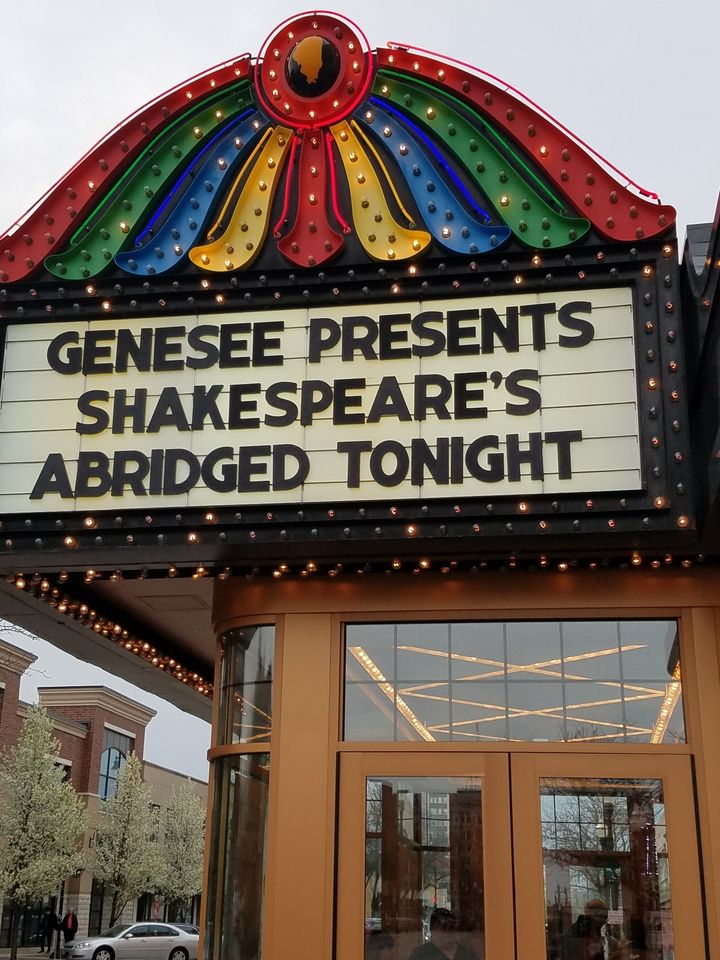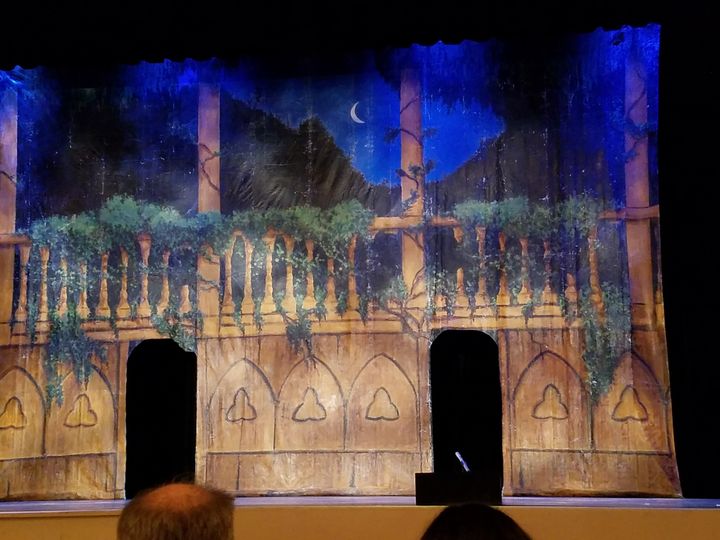
Shakespeare’s Long Lost First Play (Abridged): the abridged title, 28 April, 2017
Midway through the plays-within-plays-within-plays of Shakespeare’s Long Lost First Play (Abridged), Austin Tichenor stops the witty, lightning-quick exchanges and seemingly effortless costume changes to read a Folio-sized manuscript in silence. It’s his character’s effort to prevent fellow playwright Reed Martin from cutting any more of the new play of Shakespeare’s they’ve miraculously uncovered and have decided to stage. It’s also a good joke: he literally returns to the text rather than read it aloud as expected, to Martin’s exasperation, and in the process mocks Shakespearean purists by stopping the performance. And this is a play that is, above all, all about performance.
On one level, the play is about the three-man troupe of the RSC (Reduced Shakespeare Company), Tichenor, Martin, and Teddy Spencer, who try, with no lack of ambition, to stage Shakespeare’s first play, which boasts 8 pairs of twins, 100 hours of traffic, and 1,639 characters. But on another level, Shakespeare’s uncovered story itself also revolves around the meddling of rival would-be-playwrights, as Ariel and Puck battle it out, messing with the most loved and loathed of Shakespeare’s creations. In this world of literary and temporal doubles and matryoshka-doll-like narrative frames, Martin and Tichenor stage the debate all-too-familiar for any editor or director of Shakespeare’s plays: are we more “true to the text” if we read it, or closer to the Bard when we meddle and cut it up like Puck and Ariel, or the RSC? And, while maybe a bit heavy for this quick-paced, quadrupled comedy of errors, there seems to be a larger question at stake, namely: how should we consume Shakespeare any way, as artists and audience members belonging to a post-post-modern rather than early modern world?

Genesee Theater interior, 28 April 2017
Perhaps more than the average playgoer, I was thrilled when the play staged this reading vs. performing bit, as, on a personal level, I read some early drafts of the Long Lost First Play but had not yet seen it in action. I hadn’t always appreciated the difference between the page and the stage. I spent an embarrassing amount of time in the past viewing Shakespeare’s plays as part-very-big-poem, part-novel, until I finally learned that a) those things were plays not really long poem-novels and b) the theater-house is very different from my apartment, for reasons that likely go beyond the scope of this article. To this day, even with a doctorate in the field and experience in editing the more arcane of Shakespeare’s topical references and footnotes, I still don’t get all the sexual innuendos and bawdy wordplay that just make sense when the right comic actor speaks and mimes the oftentimes very explicit humor.
It’s important to remember that Shakespeare wrote his plays to be performed in a live, raucous theater, where audience members hawked apples and hazelnuts, and actors played a different role every night. Though recent textual scholarship reminds us that, yes, Shakespeare, along with other contemporaries, probably edited and revised his plays for readers, he was clearly in the business of staging plays to be seen and heard.
Nevertheless, there is no doubt an elitist bias that pits the ostensibly more “active” experience of reading against the “passive” reception of spectatorship: the very same perspective that would be impressed, say, when one reads Shakespeare’s histories, but not so much when one watches the PBS “Hollow Crown” miniseries of those same plays. From within this perspective, we often find the cult of the capital-B Bardolatry. His text, iambic-pentametered and early-moderned, is so enmeshed in cultural citation and within the realm of High Art that it threatens to lose its raw and disruptive power, becoming instead important-sounding proverbs: that is, Shakespeare’s “universals” rather than something actually living.

The Set, Genesse Theater, 28 April 2017
In their clever mash-up of Shakespeare’s lines – “O, if a Muse of fire be the food of love, play on!” – Tichenor and Martin succeed in making the text live in their hyper-cognizant way. We find Beyonce, the Gilligan’s Island theme song, and Disney ballads alongside characters forced into odd and often perverse encounters. Beatrice from Much Ado falls in love with Kate from The Taming of the Shrew, a boy-crazy Juliet chases Dromio from The Comedy of Errors. You can feel the subversive fun the playwrights had in imagining well-known characters in totally new contexts (Lady Macbeth: meet Hamlet). Doubles abound from the meta-frame to the twinned characters (e.g., Ariel/Puck, Malvoliago, Arden-Birnam). It’s an unsettling and creepy metaphor, but Martin and Tichenor have created the love-child of Shakespearean critics A.C. Bradley and Northrop Frye, Bradley famously re-imagining Shakespeare’s characters in other plays – e.g., if Hamlet was the lead in Othello or Othello the lead in Hamlet, there would be no tragedy – and Frye illuminating the repeated archetypal structures of character “types” and plots repeated endlessly – the “green worlds” and shipwrecks, angry fathers and malcontents.
That’s the thing with Shakespeare’s Long Lost First Play – as much as it rejects the purist injunction to read the text, staging instead the cutting, adapting, and iconoclastic smashing of idols – the play offers its own reading of Shakespeare. They may not be always literally reading to themselves onstage, but they are at the very least interpreting their own interpretations.
But witnessing the RSC’s hilarious remix taught me more about the entire enterprise of making these playful stories about stories than reading it alone ever could. The sheer energy involved to pull it off is staggering to imagine, yet it is an effort that is made to seem effortless. The Renaissance had a word for it: sprezzatura, and the trio and their crew have it in spades. In a show filled with familiar and obscure references and a sea of characters, where the same actor plays Juliet, Hamlet, Falstaff, Richard III who turns into Richard II, and William Shakespeare himself: in this show, surprisingly, the audience doesn’t miss a beat, nor do the actors, who disappear seconds behind the stage-set to throw on a small signal of this transformation. A skull for Hamlet, a Disneyified Mermaid tail for Ariel, a large belly for Falstaff. The RSC set out an explicitly impossible task – we’re in Act 4, Scene 2079 – only to astound us as they pull it off, all the while insisting that they’ve failed. The gag doesn’t stop being funny, nor does the show.
More than their skill in pulling it all off, the actor’s energetic performances made me realize something larger about Shakespeare and his company that I too often willfully ignore. The Lord Chamberlain’s Men and King’s Men would not have been successful, even with Shakespeare’s for-all-time-remarkable scripts, if they did not have show-stopping performers to bring the words into life: to transform the hastily-written words of their parts into the stories that deeply affected their audiences. This isn’t news to any one in the biz, but actors have the power to transform the meaning and shape of lines even without altering the content. Teddy Spencer’s final lines in this play hold such a power over the audience: he toes the hair-thin line between pathos and comedy with words that could have easily been played as fully one or the other.
So, don’t just read about it: go see it.
